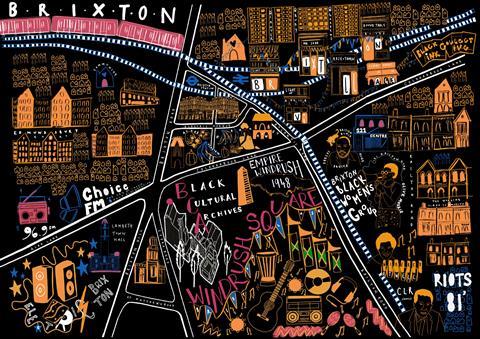The displacement of the Black community in Brixton is causing ruptures in long-established neighbourhoods and highlighting issues around economic disparity, writes Shanice Abbey

Cities have always been places of transition, defined by histories of personal sacrifice, opportunity and displacement. The human migrations that often underpin these narratives are undertaken for a multitude of reasons, ranging from urgent necessity to the desire to seek new beginnings.
London has been the stage upon which countless stories of displacement have been played out for centuries. My recent work focuses on the specific experiences of the Windrush generation, celebrating their rich cultural roots and their role in defining multicultural London, particularly within Brixton.
My artwork The United Colours of Brixton (2022), was commissioned by Blueprint for All as part of their on-going “Connecting People and Places” programme, which is designed to increase recognition of how migrant communities have influenced heritage across England.

The artwork celebrates the huge contribution of the Afro-Caribbean community to the identity of contemporary Brixton. But my work also maps a more recent history of displacement, as new pressures have brought rapid changes to the physical and socio-economic character of the area.
Displacement occurs through a series of ruptures in which residents, businesses and industries suffer over a long period. These ruptures induce a series of emotional, mental and physical states of anxiety, isolation, dislocation, longing, loss and heartbreak which unfold over time.
My work seeks to understand the renderings of territories, the movement of people, and the patterns that evolve throughout such contested spaces. My challenge was how to capture the complexity of this narrative in a single image.
Today the dynamics of Brixton are fast changing
The United Colours of Brixton (2022) draws on the personal and collective representations of everyday life, magnifying these moments, drawing on the communities’ roots, and engaging with collective stories. It is centred around the Grade II-listed building of the Black Cultural Archives on Windrush Square. The site is the only national heritage centre dedicated to preserving the legacy of the Black presence in Britain.
Through my illustration I seek to explore how over time Brixton was the heart of Black culture in London, re-engaging with the history of the community that built the name, and uncovering the hidden Brixton.
Today the dynamics of Brixton are fast changing, dissolving previously familiar cultural nodes, people and places. Cultural displacement within urban spaces is often rooted in economic-induced displacement. When a community is priced out of their neighbourhood, this can lead to a transition in the provision of shops and services that may not adhere to previous tastes, norms or desires.
Displacement is a route into a discussion about socio-spatial injustice
This can be reflected in the erosion of an ethnic enclave, manifested in subtle changes in spatial typologies and desired consumption of spaces. When a spatial identity is threatened, this can become an alienating experience. Loss of visibility within their spatial boundaries can become internalised and lead to a profound loss of self-pride in a community.
For those displaced, there can be a sense of rupture in how they experience their urban spaces. These scars can become a barrier between people and place. The change of neighbourhood dynamics can also disrupt the social mobility of the existing communities.
In the borough of Lambeth alone the child poverty rate is 43%. The privatisation of public space and the economic displacement of existing communities is likely to only exacerbate these challenges.
Displacement is a route into a discussion about socio-spatial injustice. It is through the ruptures of urban spaces, that we can begin to reveal the violence that displacement can bring to individuals, communities and society, highlighting a much larger debate about social disparity.
Postscript
Shanice Abbey an architectural designer and freelance illustrator.
















4 Readers' comments